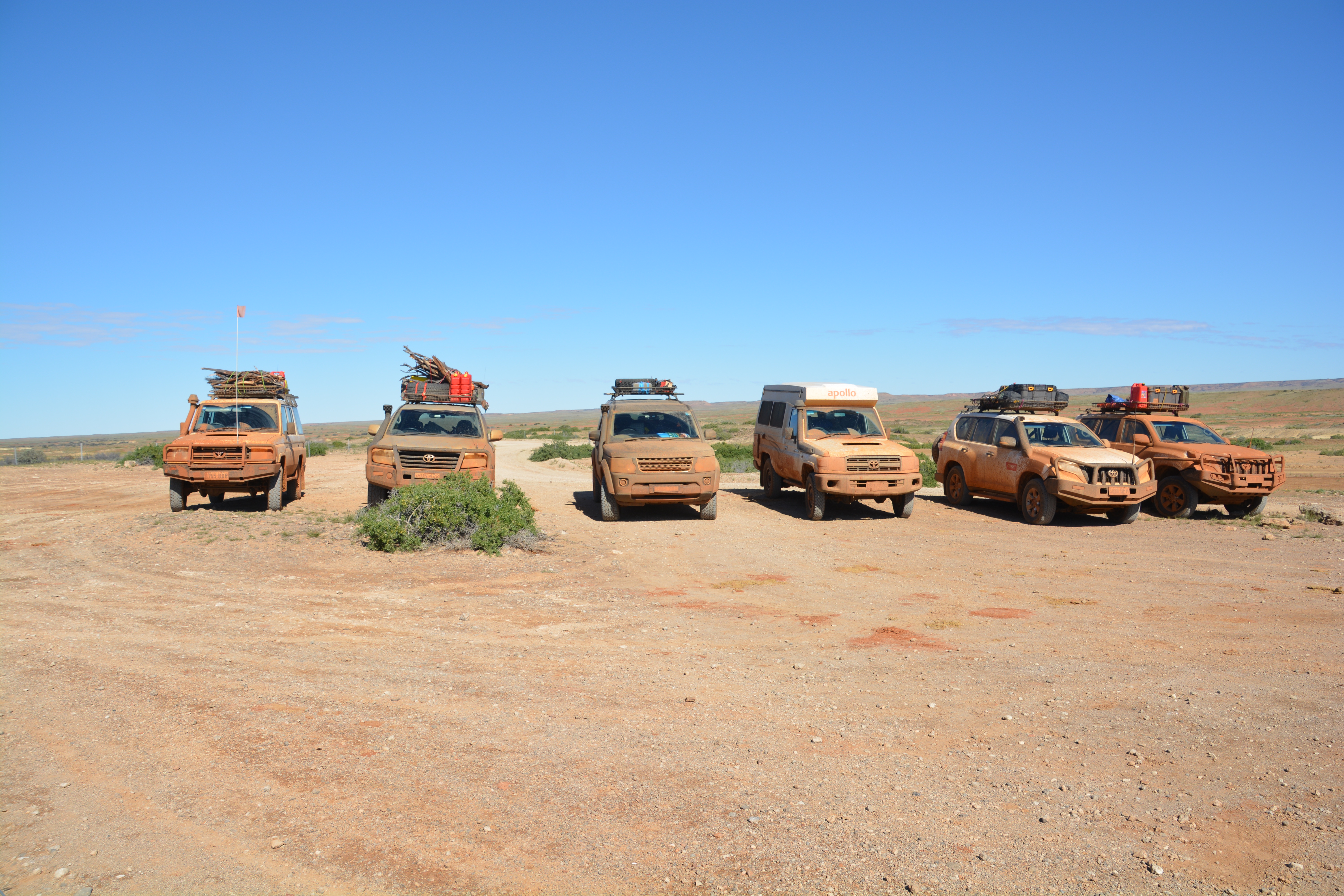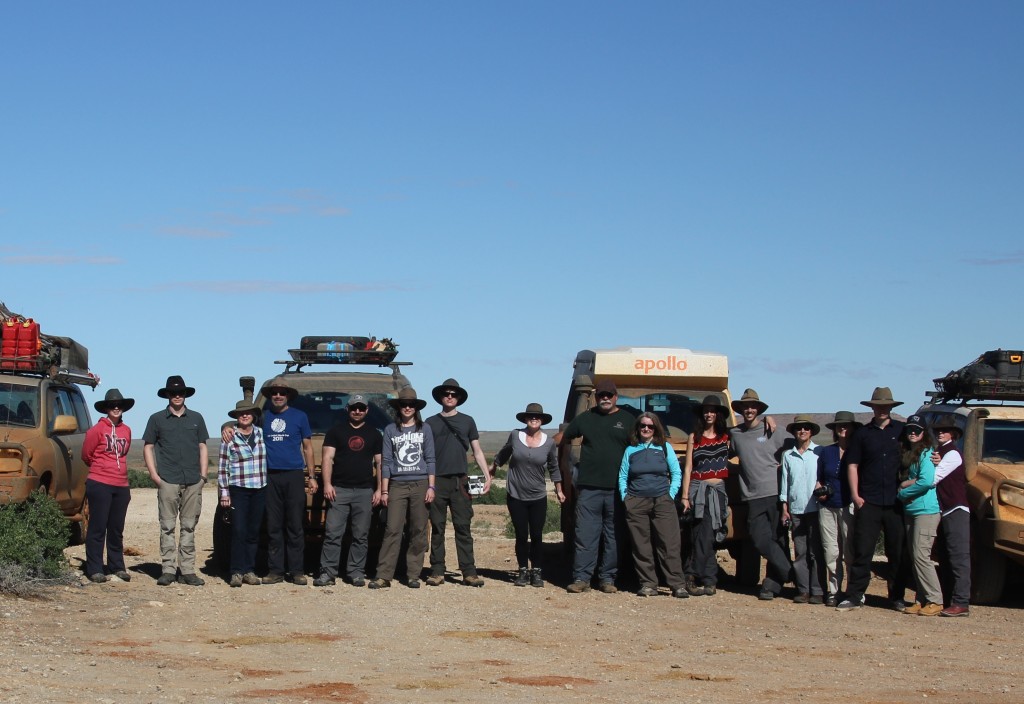Nobody mentioned a green desert
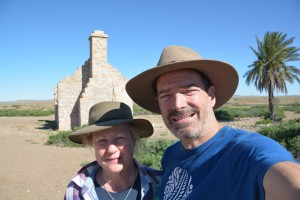
At the the Dalhousie ruins with its story of the first European settlers in this region
We left the relative comfort of the Pink Roadhouse in Oodnadatta and headed off on a muddy track with the plan to take five or six days to across the Simpson Desert. After almost two years of planning for this moment it had finally arrived and our team of 17 adventurers were keen to get started. But we also knew the circumstances of our crossing were not ideal – all the recent rain meant we would have many challenges fording rivers, crossing lake beds that are usually bone dry and climbing 1,100 sand dunes along the way. In other words – perfect!
The road started off very wet in spots and we had to drive hard through heavy mud many times. But the desert terrain was just beautiful, the scrub was green with a lot of fresh growth everywhere and it was sometimes hard to believe we were entering one of Australia’s greatest sandy deserts.
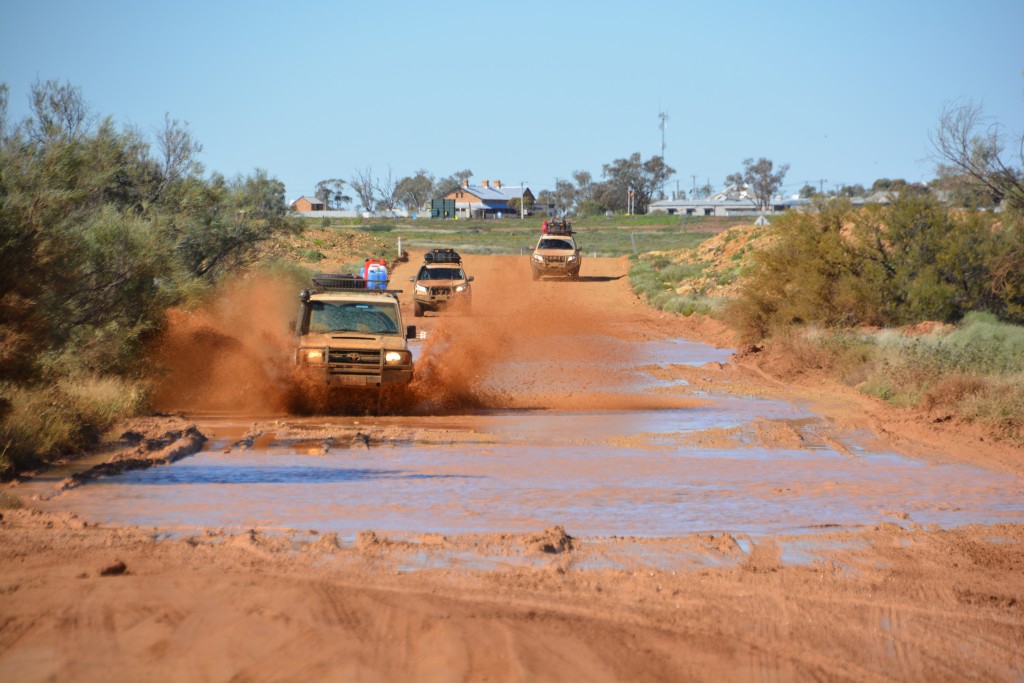
With Oodnadatta still in the rear view mirror the road got very messy
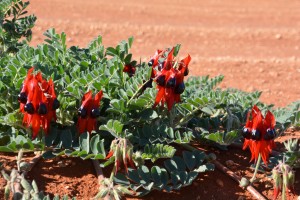
The very rare and quite odd looking Sturt Desert Peas growing on the side of the road
After lunch we started to roll over gentle sand dunes, almost camouflaged by the green bushes and desert grasses. Channel 15 crackled with green desert jokes and the need to start counting sand dunes. And the convoy came to a screeching halt when we saw the beautiful, rare and somewhat odd looking Sturt Desert Peas growing on the side of road. This was a rare treat and worthy of many photos.
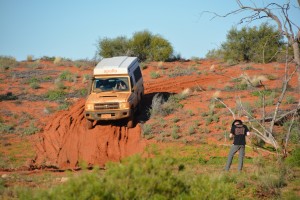
John and Kathy negotiating a short deep dip in the loose red sand
We passed over more rolling hills, across numerous dry creek beds and many short sections where the mud was deep and the driving more technical. This was not only good fun, it was good experience for the drivers as they tested their vehicles and came to appreciate their capabilities in challenging conditions.
In the late afternoon we came to the Stevenson River, a very substantial river spreading out over two large water holes that had to be crossed. The water was moving fairly swiftly but we knew all previous vehicles had somehow made it across. The thick stand of gums lining the river bed gave us no other options – this was the only way across the river.
As the lead vehicle, and with some trepidation, I shifted down into low and drove in. The mighty Cruiser, which has never missed a beat and never let me down, immediately slid into the deepest ruts hidden beneath the muddy brown water and a wave of water washed over our bonnet and onto our windscreen.
For a brief dramatic moment the Cruiser was more a submarine than a four wheel drive but it worked hard and climbed out the other side of the crossing, water entering into the cab through the glove box and through my driver’s window which I had cleverly left open. A triumphant moment for the Cruiser but suffice to say our hearts were racing.
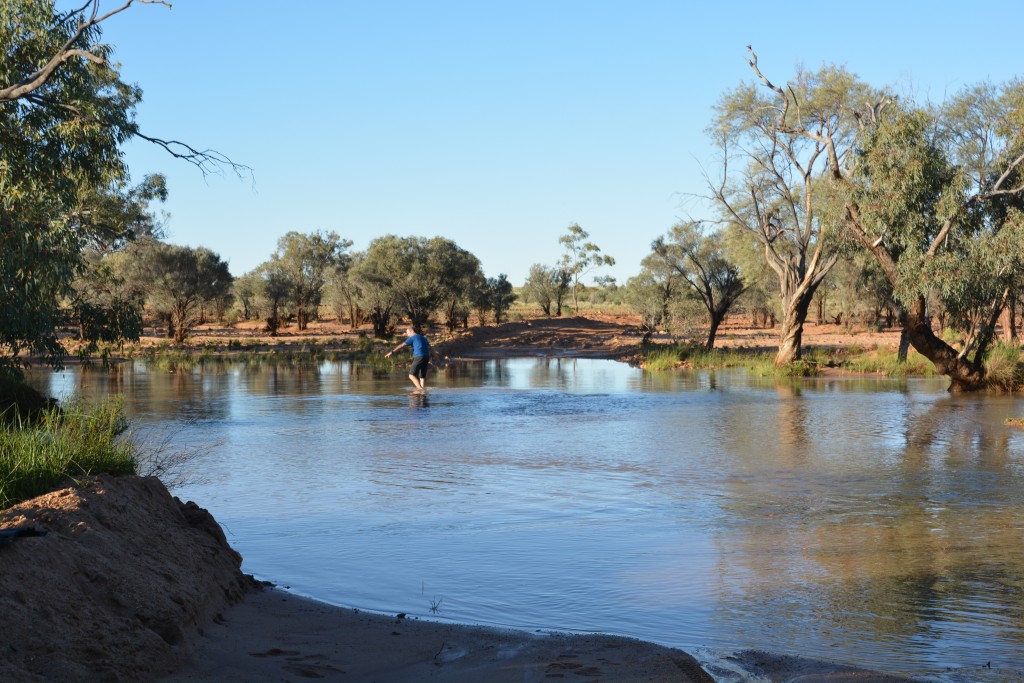
After our first scary crossing to the middle of the river I walked the second half to check on its depth
We were now parked on a sandy island between the two water holes with the other five vehicles on the banks behind us. I took off my shoes and walked across the second water hole, carefully finding the shallowest and safest path to cross. I then walked back into the deep hole we have just driven, removing a couple of sunken logs and eventually finding a safer and shallower path which I marked with a stick for the drivers to use as a guide.
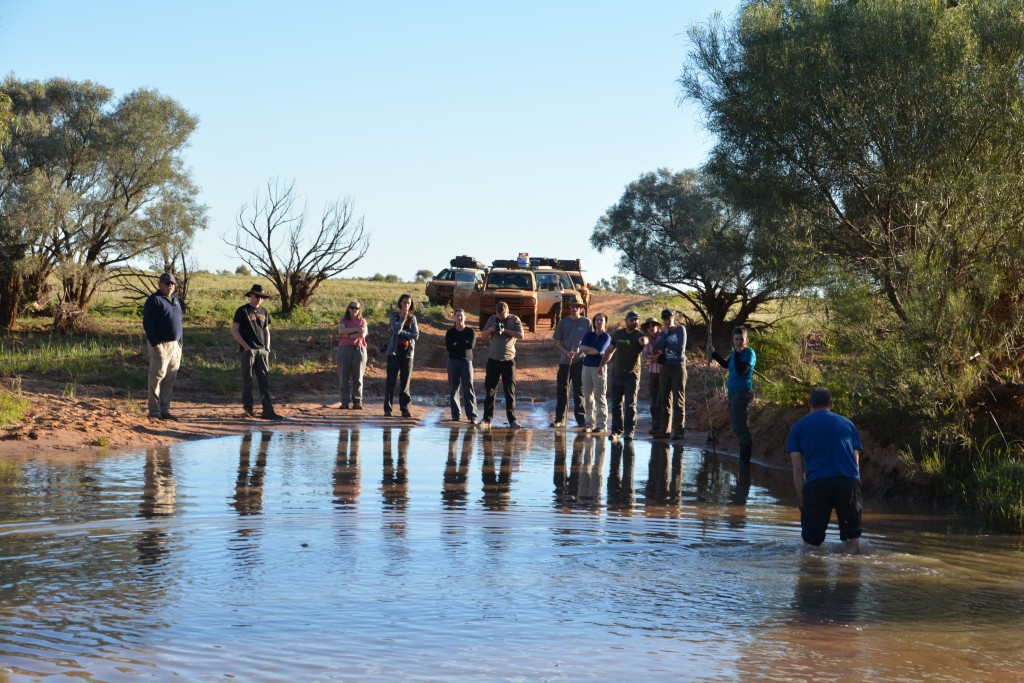
I walked back to the deep hole and eventually found a safe path for the other cars to cross
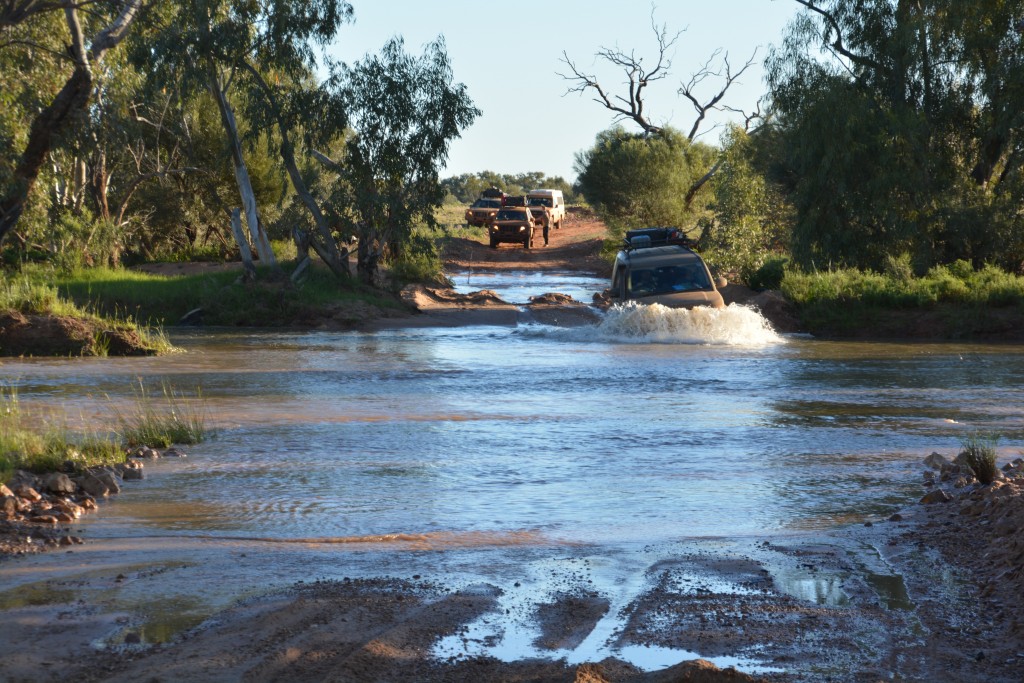
Each driver had to concentrate on taking exactly the right path across this wide water crossing
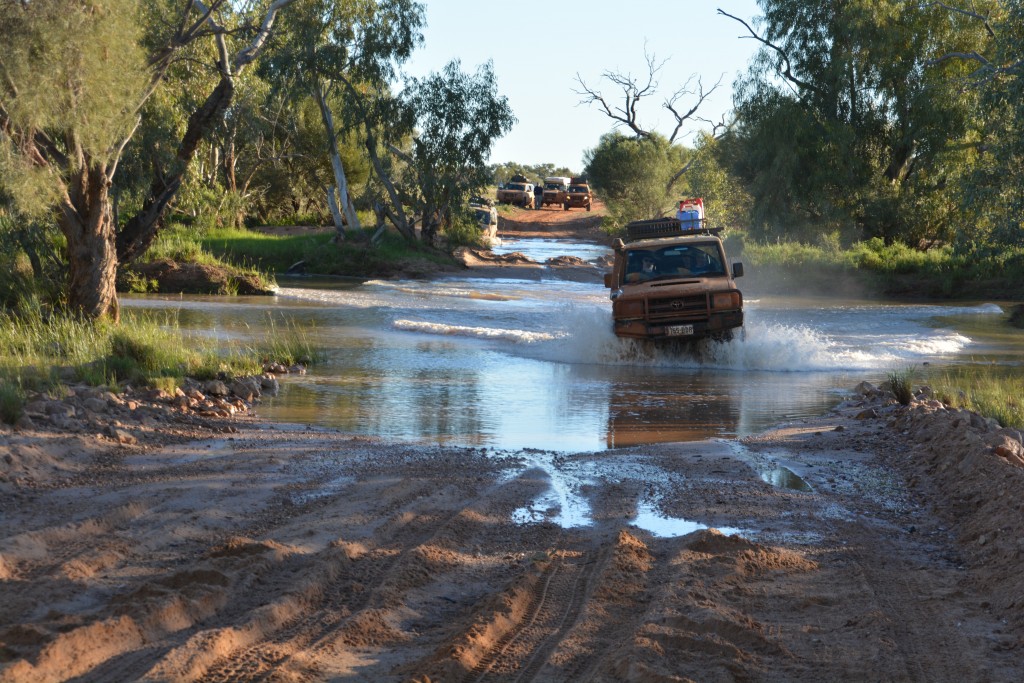
In the end it was all good fun as everyone made it across without incident
And in this way, slowly and carefully, all the cars were able to cross both holes in the Stevenson River and laugh about it afterwards. We had successfully negotiated probably one of the most technical driving manouveurs of our journey. A very exciting but scary moment, let’s not do it again.
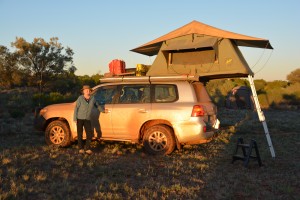
The car was a little dirty that night as we camped on Hamilton Station
We continued on along these green desert plains across the Hamilton Station and eventually found a side track for a beautiful place to bush camp. It was another great night around the fire with the group knowing it had survived its first major challenge and was ready for more.
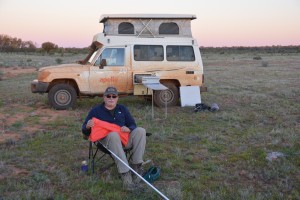
It is the law that every vehicle must have a flag and the ever-resourceful John made his own
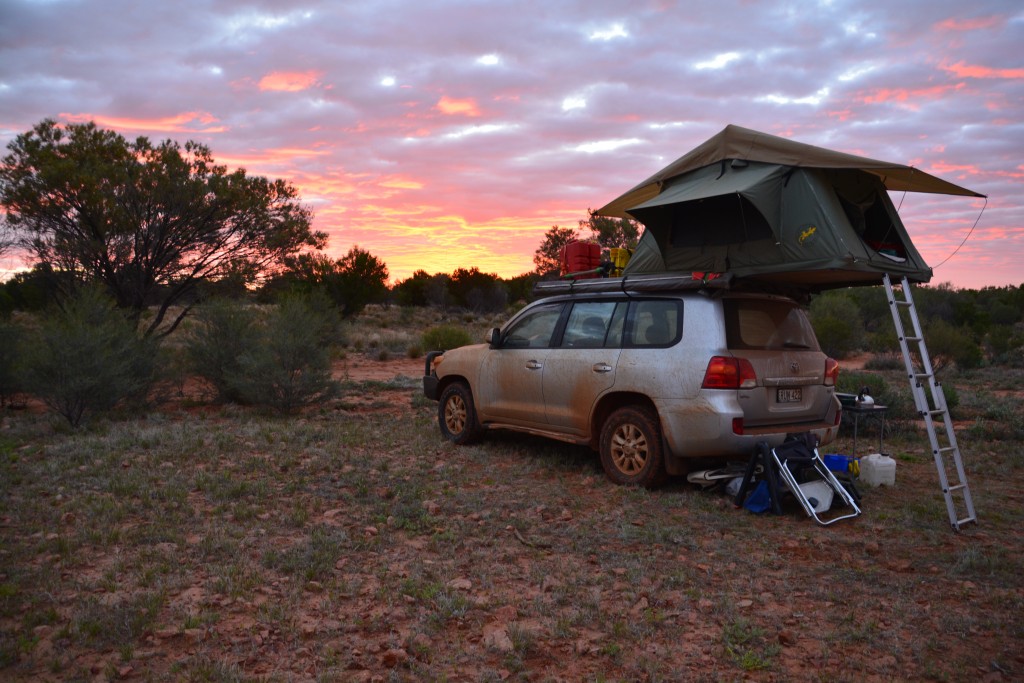
A stunning sunrise over our camp on Hamilton Station
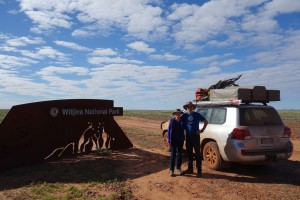
Entering the Witjara National Park – a place that definitely deserves a return trip
The next morning we woke to a beautiful sunrise and the tracks of a herd of cattle that silently walked through our camp during the night. We soon entered Witjara National Park which protects this western section of the desert and continued the drive across the grandest of spanning views until we came to the Dalhousie ruins.
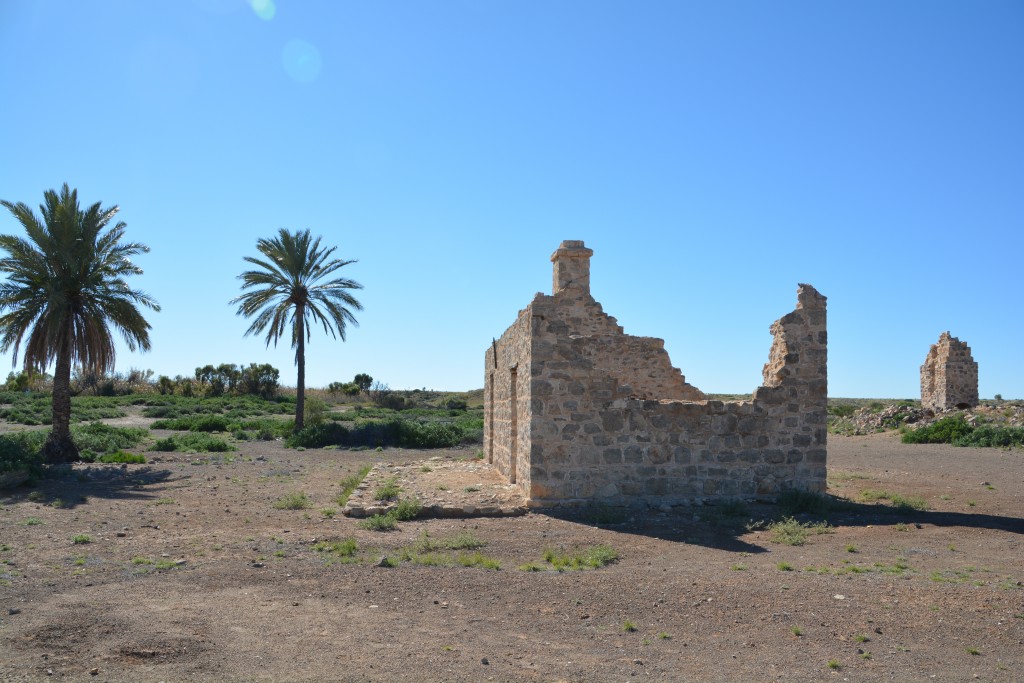
Dalhousie Station was established more than 120 years ago in this remote and barren land and today only a few stone walls, some fences and the palms trees remain
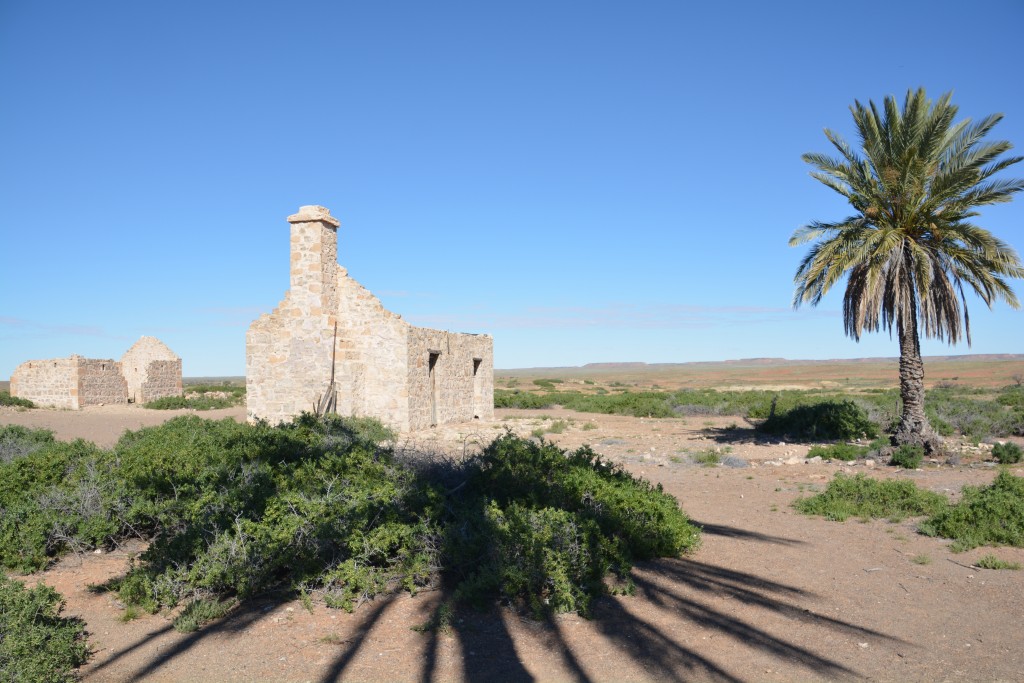
The palm trees at the ruins are the only things still benefiting from the deep springs here
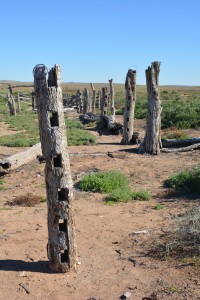
Old hand carved fence posts tell the story of the hard working pioneers
These sun-bleached ruins are all that remains of a remote station that was built here in the 1890’s. A group of very hardy and resourceful pioneers working with local Aborigines carved out a bare existence in one of the most inhospitable places on the continent. We walked amongst what was left of this small settlement, remote beyond all imagination with only its artesian spring to sustain life, huge palm trees and cattle yards still standing, trying to imagine what life must have been like here over 100 years ago. They made ‘em tough in those days.
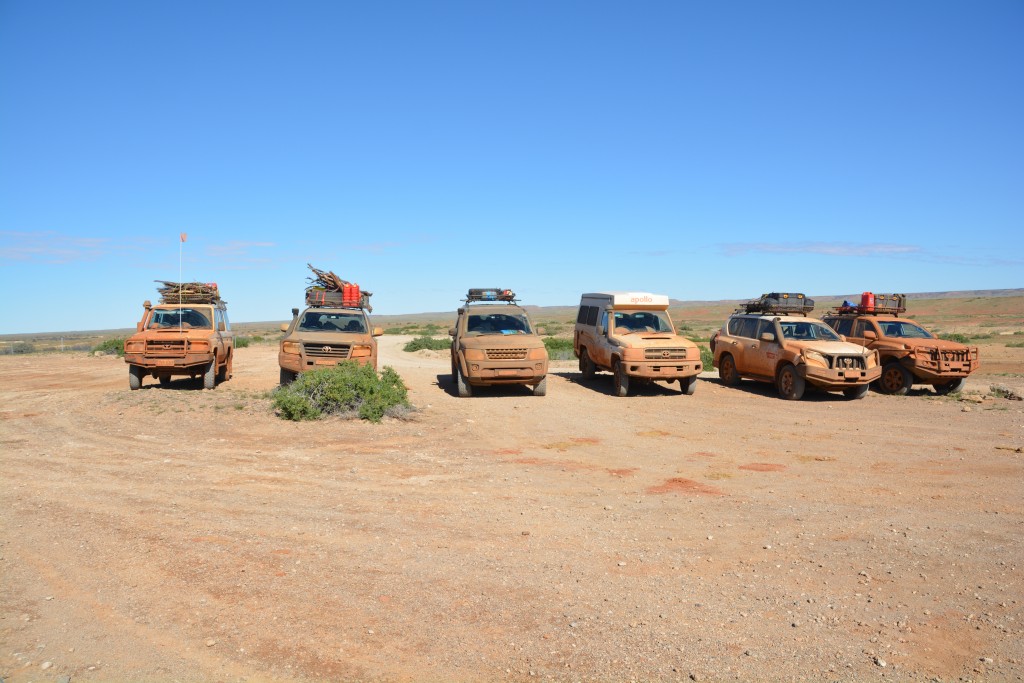
Our fleet of handsome expedition vehicles rest between challenges
Will took some spectacular video and photos of these historic ruins with the drone and it later flew along behind us for 15 minutes as we drove along the dunes. Try this:
We drove on to Dalhousie Springs, a major stopping point for all desert travellers due to its hot springs. Like other places in the desert, the water from the Great Artesian Basin deep down below the earth’s crust somehow oozes its way to the surface. We parked and went down to the water hole, in itself a bit strange out here in the middle of nowhere, for a swim in 40 degree water.
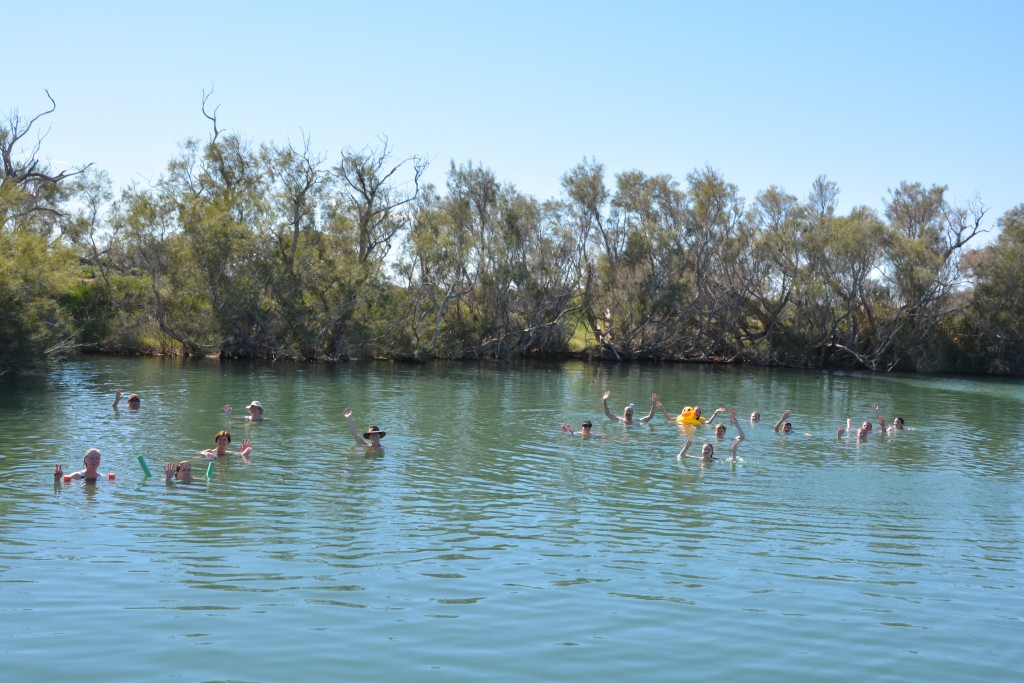
Where’s that desert again? Swimming in the very warm waters of Dalhousie Springs
This was great fun, a chance to wash the dust off, paddling around on the floatable noodles that we found there and enjoying this unique experience. The spring was probably 120 metres long by 30 metres wide and allegedly 14 metres deep. Such a huge body of water staying so hot in such a remote place, quite a geologic oddity and a very special treat.
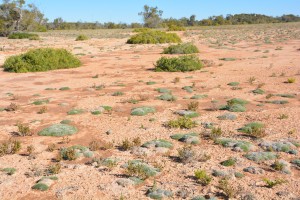
The desert has many colours in it
Having enjoyed our swim in the desert, as you do, we continued across the flat plains, green shrubs and new growth everywhere. If it wasn’t for the deep red sand and the endless horizon you couldn’t pick the desert.
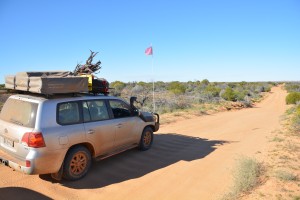
The Cruiser stops for photos and to enjoy the lush desert scene
There are many tracks across the Simpson Desert, and we were going to explore a few of them, but the primary track across is called the French Line, named after the French petroleum company who carved it out in the last century as they explored for natural resources. For at least this day we would be following this track on our eastward journey.
At one stage we crossed a beautiful creek with blue clear water, the first we’ve seen all trip, and stopped for photos and to let the drone fly again. The water in the river was slightly salty to taste, another curious phenomenon amongst all these artesian wells and springs.
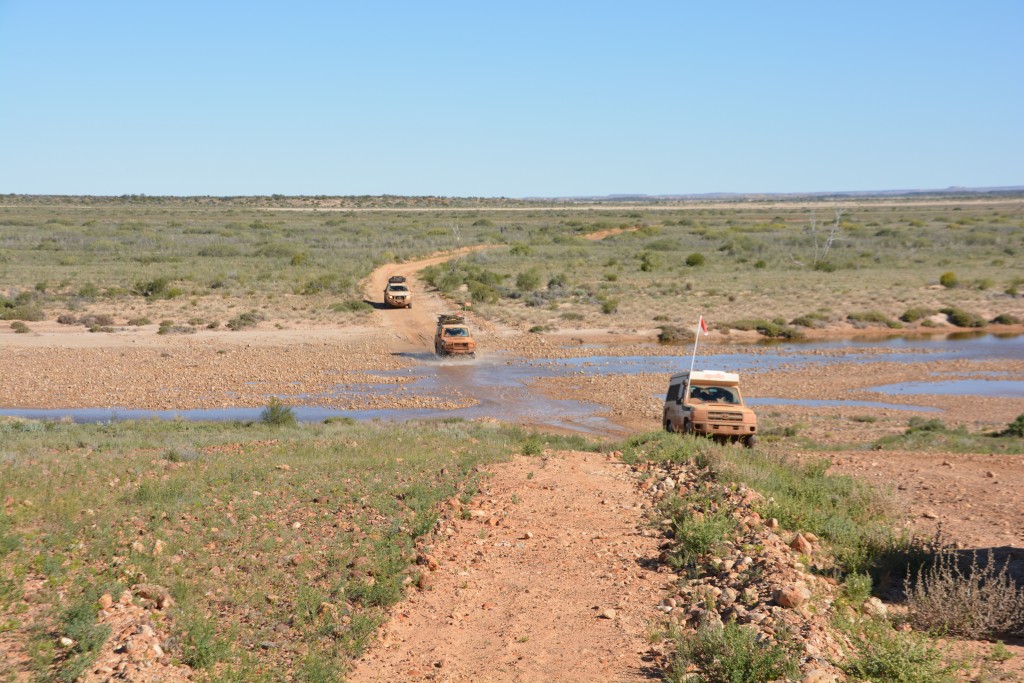
A river with clear blue – and slightly salty – water is a rare sight
Driving further in our eastern direction, at one flat open plain there were substantial flooded spots and previous drivers had started detouring to the right, forging tracks heading in all directions as they explored options on the best way around the forbidden mud. Such was the expanse of pool water and mud that the detoured tracks kept veering further and further away from the intended track until at one point we were probably 500 metres off course before finally joining back up. Nothing was easy.
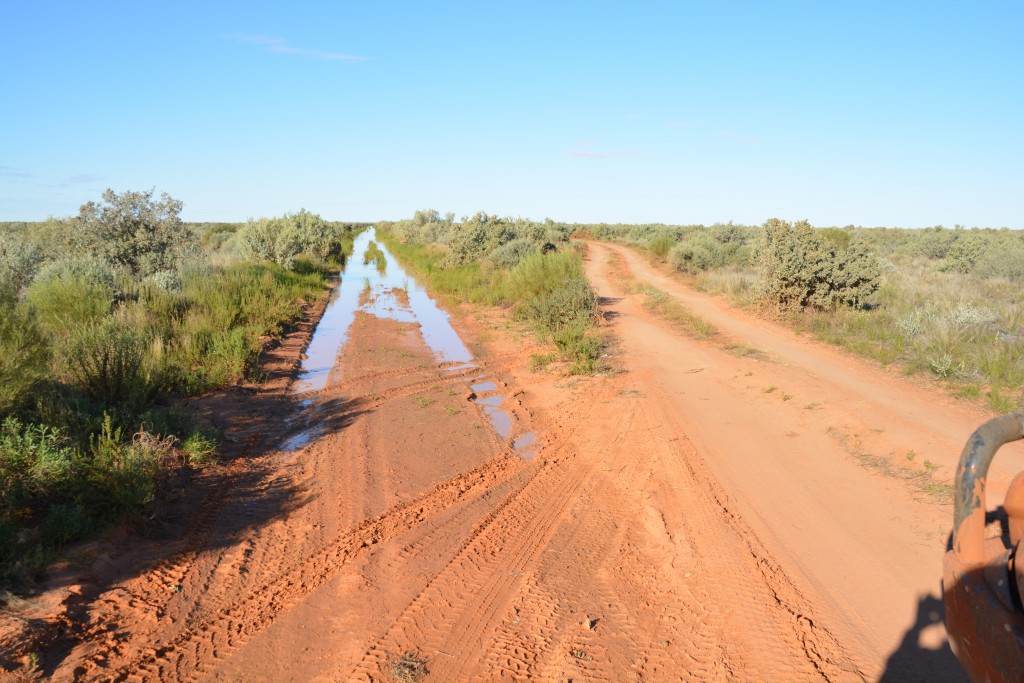
Which track should I take? Recent flooding created many detours
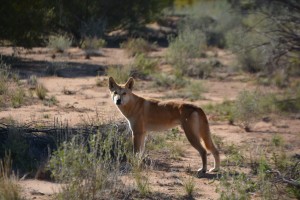
A beautiful shiny dingo watched us with curiosity
The sand dunes were now quite obvious, some more than five metres high, deep red sand with colourful flowers and plants all over them. At one stage we stopped at the top of one of the higher dunes for photos when Julie saw a dingo crossing our path. His coat was light brown and healthily shiny and he was as curious about us as we were of him. And then, amazingly, another one appeared behind us. A great experience, the first dingo sightings for many people and a real treat.
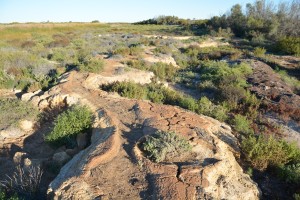
Purni Bore was an odd place – a natural spring unnaturally capped but still showing life
The rolling desert track continued until we came to a place called Purni Bore, another artesian spring similar to what we had seen at Dalhousie Springs. This spring was drilled by the French many years ago and created a wetland which grew to feature migrating birds and other wildlife before being capped in 1987. It now only releases a small amount of water but signs of the wetland still exist and it is quite an oddity in this vast desert. To add to the unique nature of the place, a shower and toilet block was built nearby featuring natural hot showers!
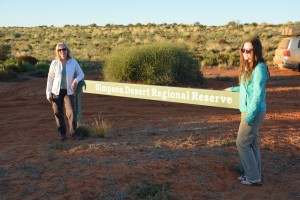
Jacinta and Kathleen pose at the start of the Simpson Desert Regional Reserve
The Witjara National Park is a wonderful place, full of wonders with its history of settlement, its sweeping desert and its many artesian springs. But we wanted to camp outside its borders because fires are not allowed in the park and being ever resourceful we had brought plenty of firewood to keep us warm at night. We covered the last 10 km outside of the park as the day’s light became low and the red sand dunes glowed. We found a beautiful spot between the dunes and set up a lovely camp, dingo and camel prints in the sand nearby, the end to a wonderful day.
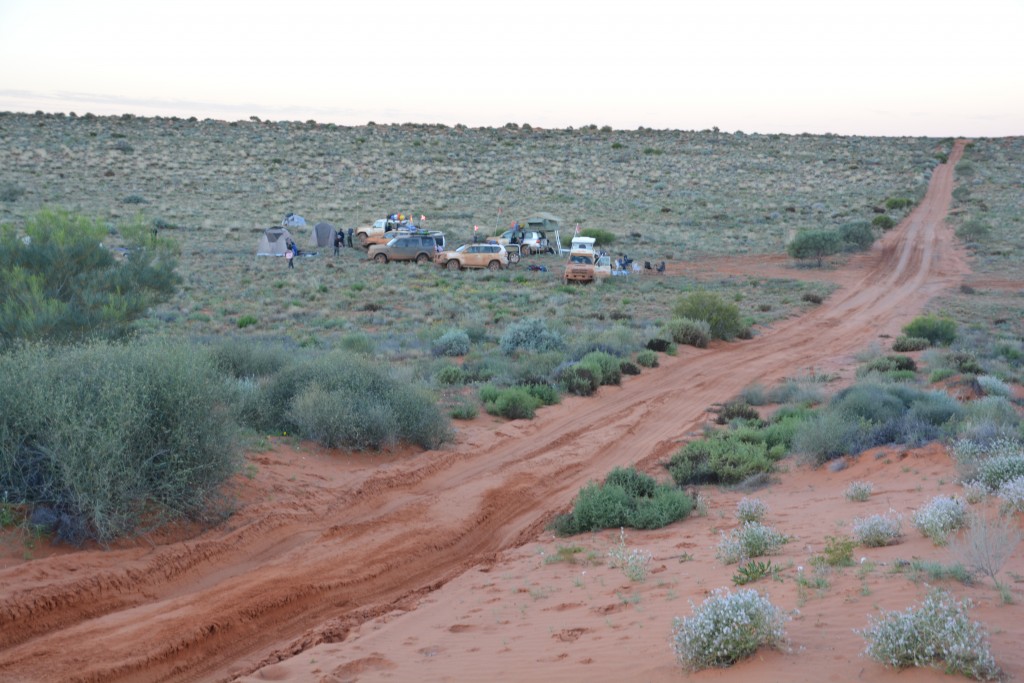
Our campsite just before dusk – a beautiful setting to end another great day
Our first two days across the desert from Oodnadatta had been much more varied then we had expected with its endless horizons, its pioneer history, its natural springs, its wildlife and its beautiful green sand dunes. But camping between two large dunes that night, sitting around the warm fire and admiring the endless span of stars in the sky we could only wonder what might lie ahead for us.

A panoramic view of the desert
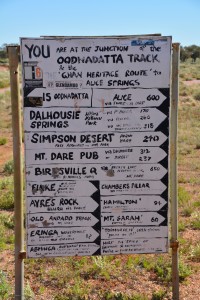
Road signs in the desert were very informal but full of information
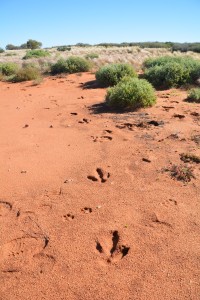
Giant emu prints in the soft sand look almost dinosauric
